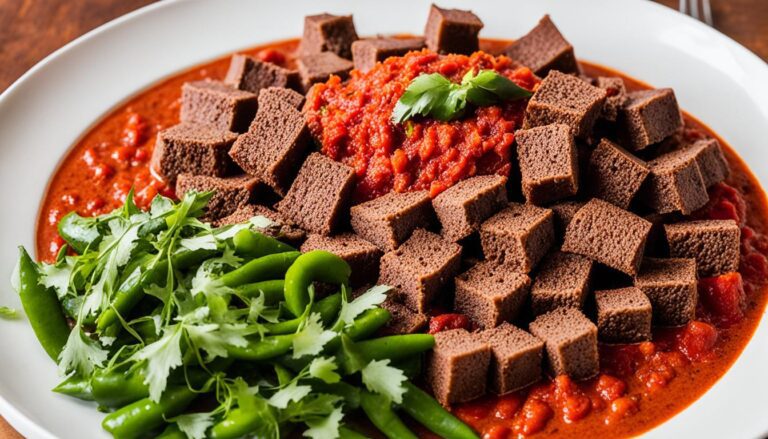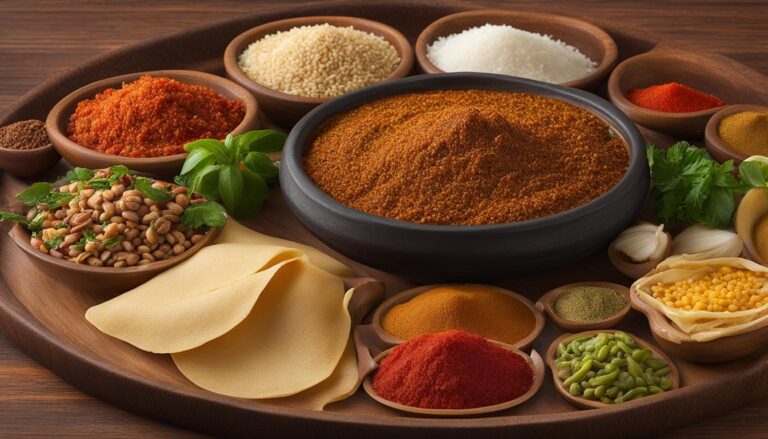Is Ethiopian Food Healthy?
When it comes to seeking healthy and nutritious meals, the options can sometimes feel limited. But have you ever considered Ethiopian cuisine? With its tantalizing flavors and unique culinary traditions, Ethiopian food may just surprise you with its health benefits. So, is Ethiopian food really as healthy as it seems? Let’s uncover the truth and delve into the world of Ethiopian cuisine.
Key Takeaways:
- Ethiopian cuisine is primarily plant-based and incorporates nutrient-packed ingredients like lentils, grains, vegetables, and legumes.
- Injera, a traditional Ethiopian sourdough flatbread, is a healthy staple made from gluten-free teff flour, rich in iron and calcium.
- Ethiopian dishes offer balanced flavor profiles that blend spices and fresh herbs, resulting in flavorful but not overly spicy or greasy meals.
- The cooking methods used in Ethiopian cuisine, such as simmering and steaming, help retain the nutrients and flavors of the ingredients.
- Ethiopian food provides numerous vegetarian and vegan-friendly options, making it an excellent choice for plant-based diets.
Ethiopian Culinary Traditions
Before we delve into the health aspects of Ethiopian cuisine, let’s take a moment to appreciate the rich culinary traditions that have shaped this vibrant and flavorful cuisine. Ethiopian food is a reflection of the country’s diverse cultural heritage and ancient tradition of communal dining.
One of the defining features of Ethiopian culinary traditions is the unique flavors and spices used in their dishes. The combination of aromatic herbs and spices, such as cardamom, cloves, cinnamon, and turmeric, creates a symphony of flavors that tantalize the taste buds.
Moreover, the cooking techniques used in Ethiopian cuisine have been passed down through generations, preserving the authenticity and cultural significance of the dishes. From slow-cooking stews to the specialized process of fermenting the sourdough flatbread called injera, each method is a testament to the culinary craftsmanship honed over centuries.
Ethiopian cuisine also embraces a communal dining experience known as gursha. This practice involves sharing food from a communal platter, where people gather around to enjoy the meal together. It not only fosters a sense of togetherness and unity but also enhances the overall dining experience.
Exploring Ethiopian Coffee Culture
Another significant aspect of Ethiopian culinary traditions is the country’s vibrant coffee culture. Ethiopia is often referred to as the birthplace of coffee, and its traditional coffee ceremony is a cherished cultural ritual. The ceremony involves roasting and brewing coffee beans while sharing the aromatic drink with friends and family. It is a symbol of hospitality, friendship, and social bonding.
Experience Ethiopian Culinary Traditions with a traditional coffee ceremony and indulge in the warm flavors and rich cultural heritage of this beloved beverage.
As you embark on this culinary journey, keep in mind the deep-rooted traditions and cultural significance that give Ethiopian cuisine its distinctive character. The flavorful spices, communal dining experience, and coffee ceremonies all contribute to an enriching gastronomic adventure.
Nutrient-Rich Ingredients
Ethiopian cuisine is well-known for its use of nutrient-rich ingredients that form the foundation of their flavorful dishes. The traditional Ethiopian diet is primarily plant-based, emphasizing the incorporation of a wide variety of health-promoting foods. These ingredients, including lentils, grains, vegetables, and legumes, are packed with essential nutrients that contribute to a balanced and nourishing diet.
When it comes to Ethiopian cuisine, nutrient density is a key factor. Lentils, for example, are not only a great source of plant-based protein but also rich in fiber, iron, and folate. Grains like teff, millet, and barley provide essential vitamins, minerals, and complex carbohydrates, while vegetables such as collard greens, carrots, and beets offer a spectrum of vitamins, minerals, and antioxidants that support overall health.
This combination of nutrient-rich ingredients in Ethiopian cuisine ensures that individuals can enjoy a variety of flavors while also obtaining the necessary vitamins and minerals for optimal well-being.
Benefits of Nutrient-Rich Ingredients:
Including these nutrient-packed ingredients in your diet can have numerous benefits:
- Fiber: The high fiber content of Ethiopian cuisine aids in digestion, promotes satiety, and helps maintain healthy blood sugar levels.
- Vitamins and Minerals: The diverse range of ingredients in Ethiopian dishes contributes to a well-rounded nutrient intake, supporting various bodily functions and overall vitality.
- Antioxidants: Antioxidants found in vegetables and legumes help combat free radicals, reduce inflammation, and support immune function.
- Plant-Based Protein: Lentils, legumes, and grains provide plant-based protein that can be a healthy alternative to animal protein sources for individuals following vegetarian or vegan diets.
By incorporating Ethiopian cuisine into your meals, you can enjoy the benefits of these nutrient-rich ingredients while experiencing the rich flavors and cultural heritage that Ethiopian food has to offer.
Injera: A Healthy Staple
Welcome to the fourth section of our article, where we will delve into the nutritional benefits of injera – a beloved Ethiopian sourdough flatbread. Injera plays a crucial role in Ethiopian cuisine as a staple food that is not only delicious but also contributes to a healthy diet.
Injera is made from teff flour, a gluten-free grain that is rich in essential nutrients such as iron and calcium. Teff is also high in fiber, which aids in digestion and helps maintain a healthy digestive system. So, if you are looking for a nutritious alternative to processed bread, injera is a fantastic choice.
But what makes injera truly special is its unique fermentation process, which results in its slightly sour taste. This natural sourdough fermentation not only enhances the flavor but also improves the bread’s nutritional profile. The fermentation process increases the availability of certain nutrients and adds beneficial probiotics to the bread, promoting gut health.
So, whether you’re enjoying injera as a base for flavorful stews and curries, or savoring it on its own, you can be assured that you’re indulging in a healthy and nutritious food.

Balanced Flavor Profiles
When it comes to Ethiopian cuisine, one thing that stands out is its balanced flavor profiles. Ethiopian dishes are famous for combining a variety of spices, such as berbere and mitmita, with fresh herbs to create a harmonious blend of flavors. This unique combination results in dishes that are not overly spicy or excessively greasy, making them appealing to a wide range of taste preferences.
By skillfully balancing the spices and herbs, Ethiopian chefs create dishes that are flavorful without overpowering the taste buds. These meticulously crafted flavor profiles allow each ingredient to shine while still complementing one another. Whether you prefer a mild or bold taste, you can find dishes that cater to your palate in Ethiopian cuisine.
The use of spices like berbere, a fiery blend of chili peppers, garlic, and ginger, adds depth and complexity to Ethiopian dishes. Additionally, mitmita, a flavorful mix of spices including chili powder and cardamom, provides a subtle kick of heat. Coupled with the brightness of fresh herbs, such as parsley and cilantro, these spices add layers of flavor that make Ethiopian cuisine truly exceptional.
To further enhance the dining experience, Ethiopian cuisine often includes injera, a sourdough flatbread with a slightly tangy taste. The unique texture and mild flavor of injera serve as a perfect vessel for soaking up the rich flavors of stews, vegetables, and lentils. This combination of injera, spices, and herbs creates a truly remarkable dining experience that highlights the balanced and intricate flavors of Ethiopian cuisine.

Experiencing the Flavors of Ethiopia
When dining on Ethiopian food, you can expect a delightful balance of flavors that will tantalize your taste buds. Each bite offers a symphony of spices, herbs, and textures that result in a memorable culinary experience. From the comforting warmth of lentil stews to the aromatic combination of aromatic spices, Ethiopian cuisine offers a diverse array of dishes that showcase the beauty of balanced flavor profiles.
Healthy Cooking Methods
In Ethiopian cuisine, cooking methods play a significant role in preserving the nutritional value and flavors of the ingredients. One of the key aspects of Ethiopian cooking is the use of simmering and steaming techniques, which are inherently healthy.
Simmering allows the ingredients to cook slowly in their natural juices, enhancing the flavors and ensuring that the nutrients are retained. This gentle cooking process helps to maintain the integrity of the food, without the need for excessive oils or fats. As a result, Ethiopian dishes are often lighter and healthier compared to other cuisines.
Steaming is another popular cooking method in Ethiopian cuisine. It involves cooking food in a vapor-rich environment, which helps to preserve the natural flavors and nutrients. Steamed dishes are often vibrant, colorful, and packed with essential vitamins and minerals.
By utilizing these healthy cooking methods, Ethiopian cuisine offers a range of flavorful dishes that are not only delicious but also nourishing for the body. Whether you’re enjoying a hearty vegetable stew or savoring tender slow-cooked meat, you can be confident that these cooking techniques contribute to a nutritious meal.
Through the artistry of simmering and steaming, Ethiopian cuisine demonstrates its commitment to creating dishes that are both delicious and healthful. The next time you indulge in Ethiopian food, you can feel good about the nourishing cooking techniques used to prepare your meal.
Vegetarian and Vegan-Friendly Options
When it comes to accommodating dietary restrictions, Ethiopian cuisine shines with its wide range of vegetarian and vegan-friendly options. Whether you follow a plant-based diet or simply enjoy incorporating meatless meals into your routine, Ethiopian food has something for everyone.
One popular vegetarian choice is Shiro Wot, a flavorful spiced chickpea stew. Packed with protein and bursting with aromatic spices, this dish is a delightful explosion of flavors. Served with injera, a spongy sourdough flatbread, Shiro Wot makes for a satisfying and wholesome meal.
If you’re more inclined towards lentils, Misir Wot is a lentil stew that will tantalize your taste buds. This hearty dish showcases the natural richness of lentils, combined with a fragrant blend of spices. Paired with injera or rice, Misir Wot offers a nutritious and filling dining experience.
Whether you’re a vegetarian, vegan, or simply curious about exploring different plant-based options, Ethiopian cuisine has you covered. You’ll find an abundance of vegetable dishes, legume-based stews, and flavorful spice combinations to satisfy your cravings and nourish your body.
Conclusion
In conclusion, Ethiopian food presents a healthy and delicious culinary option for those seeking a nutritious and well-balanced diet. The cuisine’s reliance on nutrient-rich ingredients like lentils, grains, vegetables, and legumes ensures a diverse range of vitamins, minerals, fiber, and antioxidants in every meal. These elements are essential for maintaining overall health and well-being.
Furthermore, Ethiopian dishes offer a harmonious blend of flavors, combining aromatic spices like berbere and mitmita with fresh herbs. This balanced flavor profile creates a satisfying culinary experience without relying on excessive amounts of salt, oils, or fats. Such moderation enhances the health benefits of Ethiopian cuisine.
Additionally, the cooking methods utilized in Ethiopian cuisine, such as simmering and steaming, help retain the nutrients and natural flavors of the ingredients, further contributing to the overall healthfulness of the dishes. These methods minimize the need for excessive oils and fats, ensuring that the food remains nutritious without compromising on taste.
Whether you follow a vegetarian, vegan, or simply prefer nutritious meals, Ethiopian cuisine offers an array of options that cater to various dietary preferences. From protein-rich lentil stews to gluten-free injera, there are ample choices to suit every palate. Embracing Ethiopian food can be an exciting and healthy addition to your diet, providing you with a well-rounded culinary experience.







